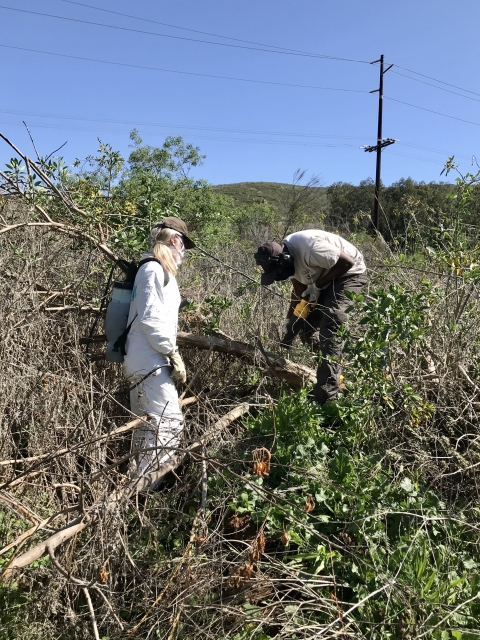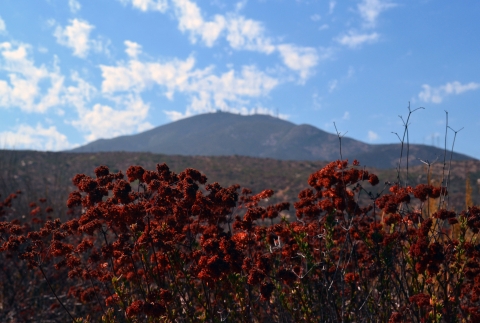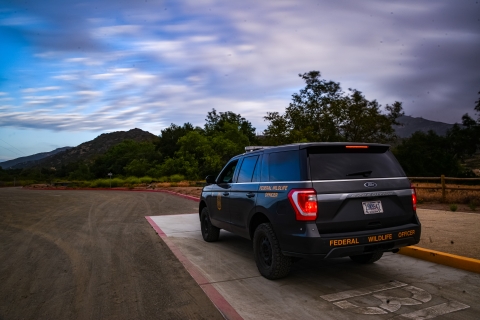What We Do
Since the Refuge’s establishment in 1996, many projects have been implemented to
restore and/or enhance habitat for the primary purpose of supporting listed and
Multiple Species Conservation Plan-covered species.
Some of these include:
• Control of invasive plant species in burn areas and in restored/enhanced areas
(e.g., cactus wren habitat restoration areas, vernal pool restoration on the
Shinohara site, and Otay tarplant habitat enhancement on the Jamacha
parcel);
• Install fencing and/or signage to reduce disturbance and minimize direct
impacts related to unauthorized off-trail activities;
• Support the Center for Natural Lands Management in their research of
effects on San Diego ambrosia of physical and chemical weed control
techniques, as the results of this research can benefit future management
practices for this species;
• Coordinate with other agencies and organizations to investigate the potential
effects to native species, particularly listed plant species, of various types of
herbicides used to control non-native grasses and other invasive plants in
natural areas; and
• Inventory and repair or replace physical structures such as burrowing owl
boxes and bluebird nesting boxes installed on the Otay-Sweetwater Unit in previous years.
Management and Conservation
In addition to the projects implemented for the primary purpose of supporting listed species, several other restoration and enhancement projects have been implemented on the Refuge to restore or improve habitat quality for a range of plant and wildlife species. These activities include controlling invasive non-native plants in recent burn areas; controlling invasive non-native grasses and forbs in other disturbed areas; removing non-native shrubs and trees from riparian riparian
Definition of riparian habitat or riparian areas.
Learn more about riparian areas; planting and maintaining oak seedlings in appropriate habitat throughout the San Diego NWR; and maintaining and monitoring restored cactus patches in recent burn areas.
Refuge Planning
National Wildlife Refuge planning sets the broad vision for refuge management and the goals, objectives, strategies, and actions required to achieve it. Planning ensures that each refuge meets its individual purposes, contributes to the Refuge System’s mission and priorities, is consistent with other applicable laws and policies, and enhances conservation benefits beyond refuge boundaries.
Comprehensive Conservation Plans
Comprehensive Conservation Plans (CCPs) are the primary planning documents for National Wildlife Refuges. As outlined in the National Wildlife Refuge System Administration Act, as amended, the U.S. Fish and Wildlife Service (Service) is required to develop CCPs that guide refuge management for the next 15 years. CCPs articulate the Service’s contributions to meeting refuge purposes and the National Wildlife Refuge System mission. CCPs serve as a bridge between broad, landscape-level plans developed by other agencies and stakeholders and the more detailed step-downs that stem from Refuge CCPs.
View the 2017 Final Comprehensive Conservation Plan for San Diego National Wildlife Refuge.
Step-down Plans
CCP step-down plans guide refuge-level programs for: (1) conserving natural resources (e.g., fish, wildlife, plants, and the ecosystems they depend on for habitat); (2) stewarding other special values of the refuge (e.g., cultural or archeological resources, wilderness, wild and scenic rivers, etc.); and (3) engaging visitors and the community in conservation, including providing opportunities for wildlife-dependent recreation. Like CCPs, step-down plans contribute to the implementation of relevant landscape plans by developing SMART (Specific, Measurable, Achievable, Relevant, and Time-bound) objectives, strategies, implementation schedules, and decision support tools to fulfill refuge visions and goals. This ensures that refuges are managed in a landscape context and that conservation benefits extend beyond refuge boundaries.
Our Projects and Research
Listed and Sensitive Species
To better understand the Refuge’s biological resources, the Refuge staff conducts periodic surveys to assess the distribution and status of its plants and animals, with a focus on the species that are endangered, threatened, or otherwise considered sensitive or rare. The Refuge has the presence of or habitat for nearly 50 such species! Surveys may include mapping the breeding territories of endangered least Bell’s vireos (Vireo bellii pusillus), a migrant songbird, along the Sweetwater River and its tributaries, or assessing the condition of dot-seed plantain (Plantago erecta), a low growing plant within openings in the coastal sage scrub that is the host for larvae of the endangered Quino checkerspot butterfly (Euphydryas editha quino). The information gathered from such surveys allows the Refuge to understand whether populations are increasing, decreasing or stable and may trigger management actions such as controlling invasive weeds that reduce habitat quality, or limiting public access to nesting areas to remove disturbance during the breeding season. Sharing survey results with other agencies and researchers enhances work to recover populations of these species across their range, with the ultimate goal of having robust populations that are no longer endangered or threatened with extinction.
Habitat Restoration and Enhancement
Habitat restoration and enhancement projects support the conservation and recovery of listed and sensitive species by improving habitat quality in the many habitat types found on San Diego NWR. These projects include controlling invasive plants in recent burn areas or those disturbed by past development or agriculture; removing non-native shrubs and trees from riparian riparian
Definition of riparian habitat or riparian areas.
Learn more about riparian areas that crowd out the native plants; planting cactus in previously burned areas to jumpstart habitat recovery for the cactus wren; planting and maintaining oak seedlings to replace those lost to disease, pests, and past human use; installing nest boxes for burrowing owls and western bluebirds; and restoring vernal pools for the suite of sensitive species associated with this rare clay soils habitat.
Habitat and Wildlife Protection
Various management strategies minimize the potential for disturbance to wildlife, and reduce adverse effects to water quality from erosion, illegal encampments, and dumping. The Refuge staff install and maintain fencing, gates, and signs; look for homeless camps, vehicle trespass, dumping, and other unauthorized activities including unauthorized off-trail activities or unleashed dogs; when necessary, Refuge law enforcement officers issue citations for violations. Abandoned mine shafts are closed to human access using wildlife-friendly gates that allow bats and smaller wildlife to continue to use the shafts as habitat. Trails may be rerouted to reduce erosion and impacts to sensitive habitats and wildlife.
Science
The Refuge supports a variety of research and resource survey work conducted in association with graduate work at various universities and/or implemented by other public (e.g., USGS, CDFG), private, and non-profit researchers (e.g., California Native Plant Society, Center for Natural Lands Management, San Diego Natural History Museum). All research conducted on the Refuge is evaluated to ensure that the work being conducted is compatible with Refuge purposes and is likely to result in benefits to Refuge management and/or Refuge resources. Work conducted on the Refuge by outside parties that are not directly related to Refuge management may only be conducted after a Special Use Permit (SUP) has been issued by the Refuge Manager.
Southern Border Fuels Project
Learn more about the project to remove non-native invasive plants along the Sweetwater River.
Law Enforcement
U.S. Fish and Wildlife Service law enforcement officers have a wide variety of duties and responsibilities. Officers help visitors understand and obey wildlife protection laws. They work closely with state and local government offices to enforce federal, state and refuge hunting regulations that protect migratory birds and other game species from illegal take and preserve legitimate hunting opportunities.
Laws and Regulations
Any activity conducted off-trails, or any organized group activity on the San Diego NWR must be approved by the Refuge Manager. In order to conduct research, observation, or any other activity, please contact the Refuge Manager Dwane Binns at Dwane_Binns@fws.gov or (619) 385-1190.





